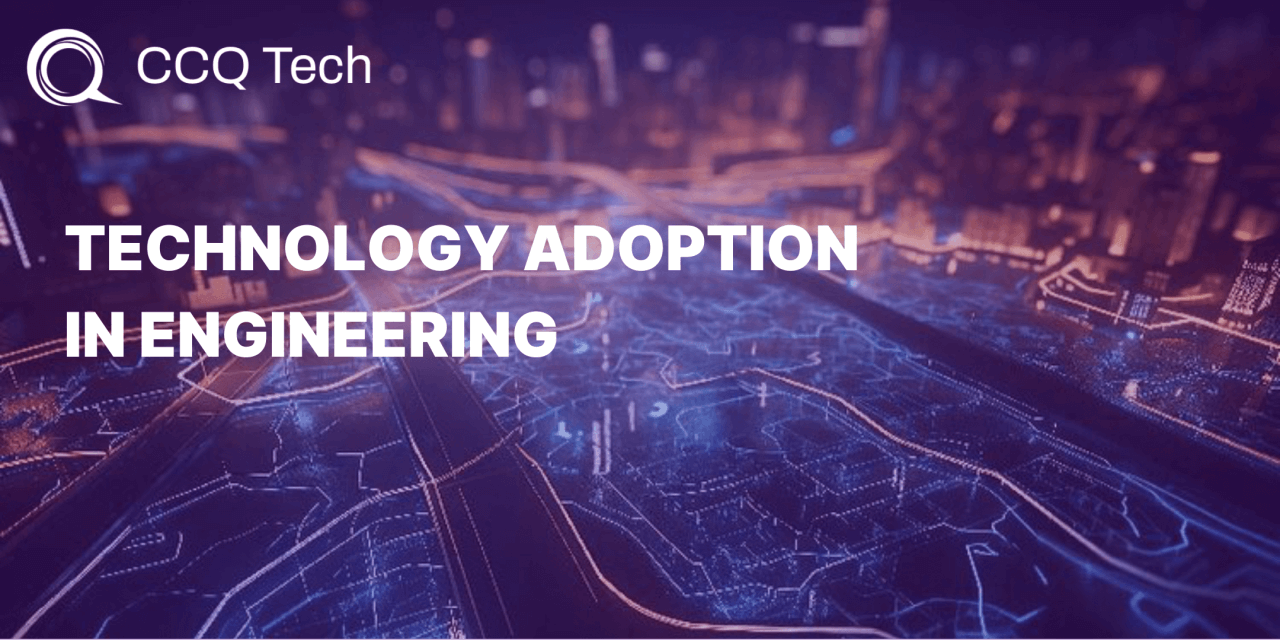
As the engineering sector continues to evolve, technology adoption is crucial to stay competitive and meet customer demands. We recently brought together directors from the engineering sector to discuss the challenges and opportunities of adopting new technologies.
Here are the highlights of CCQ Tech’s latest engineering technology roundtable, joined by 7 senior directors of UK engineering firms diagnosing business challenges, addressing adoption barriers, and maximising the value of technological investments.
Addressing Technology Adoption Barriers

Despite the recognised need for technological advancement, the directors acknowledged several hurdles in the adoption process. One recurring theme was the difficulty in standardising processes across different sectors and regions. “Because we’re such a small company and it’s a very niche area that we work in, you don’t have these big software companies that come in and have software for what you need” noted a director.
Another director shared similar concerns, describing the fragmented approach to data management. “We find ourselves in a position where we’ve got some very simple technological gains to make but nobody available to make them” he said, illustrating the challenge of balancing immediate operational needs with long-term technological investments.
Legacy Systems Integration:

Many organisations operate on outdated legacy systems that are deeply embedded into their core operations. Transitioning from these systems to more advanced technologies poses significant risks, including potential disruptions to business operations and data integrity issues.
One senior associate pointed out the challenges of transitioning from legacy systems like Lotus Notes to modern platforms such as Microsoft SharePoint:
“We switched to Microsoft a few years ago, but our team in the headquarters is keen on keeping Lotus Notes because of its structured database. This inconsistency creates complexity and isn’t user-friendly.”
Legacy systems are notoriously hard to move away from. Do you modernise, integrate, rip and replace? SME Engineering companies need to understand their options, the pros and cons and costs. CCQ run Technology Discovery Projects to uncover and clarify these options and provide recommendations based on your objectives. Email [email protected] for more information on our discovery projects.
Limited Resources:
One of the most significant barriers SMEs face is limited resources—both in terms of time and money. Smaller companies often operate with tight budgets and lean teams, making it difficult to allocate the necessary resources for technology adoption. This limitation affects several areas:
- Financial Constraints: SMEs may struggle with the upfront costs associated with purchasing new technology and the ongoing costs of maintaining and upgrading these systems. This includes hardware costs, software licensing fees, and potential infrastructure upgrades.
- Human Resources: Implementing new technology often requires specialised skills that may not be present within the existing team. SMEs may not have the luxury of hiring additional staff or consultants to manage the implementation process, leading to a heavier workload for current employees.
Change Management and User Training:

Neglecting change management and user training can sabotage even the most innovative technology. Change management in technology adoption is essential for preparing, supporting, and guiding individuals and organisations through transitions. Effective change management addresses employee resistance, which often stems from fear or discomfort with new workflows, by emphasising communicative leadership, stakeholder engagement, and robust support systems. Leaders play a vital role by transparently communicating the reasons for changes, the expected benefits, and the potential impacts on roles, thus building trust and facilitating smoother transitions.
User training is equally critical as it equips employees with the necessary skills to utilise new technologies effectively. As one director mentioned, “We need to ensure staff are trained and comfortable with new systems. Otherwise, they’ll just revert to old habits like Excel spreadsheets.” Training should be tailored to the unique needs of various user groups within an organisation, incorporating hands-on learning experiences and role-specific training modules. This approach not only enhances understanding and retention but also ensures that all team members are competent and confident in their use of new systems, thereby preventing operational failures and boosting productivity.
Integrating change management and training with organisational strategic objectives ensures that technology adoptions are not only implemented but are also embedded into daily operations and culture, maximising effectiveness and ROI. An attendee emphasised the importance of early user involvement: “Involving end users from the beginning ensures that the system is tailored to their needs and that they feel a sense of ownership.” Implementing feedback mechanisms, monitoring and evaluating technology use, and celebrating successful adoption can further reinforce change initiatives, encouraging continuous improvement and adaptation. This holistic approach not only supports the current technology transition but also prepares the organisation for future changes, maintaining its competitive edge and driving innovation.
Diagnosing Business Challenges: The Foundations of Technology Adoption

A critical first step in leveraging technology effectively is accurately diagnosing the business challenges that technology can address. “It’s crucial to recognise the business problem we’re trying to solve. Very often, technology adoption is born out of frustration because something doesn’t work, rather than a clear understanding of the outcome we’re aiming for.”
This diagnostic process involves a thorough understanding of the specific issues a business faces, which serves as the foundation for selecting and implementing appropriate technological tools. Without a precise diagnosis, there is a risk of investing in technology that does not address core problems, leading to wasted resources and missed opportunities for improvement.
When businesses clearly identify their challenges, they can align technological solutions with their strategic objectives, ensuring that the technology adopted supports overall goals. This alignment enhances operational efficiency, reduces costs, and fosters innovation. A well-defined diagnostic process helps mitigate risks associated with technology adoption, such as operational disruptions and employee resistance, by ensuring that the chosen technology integrates seamlessly with existing processes and meets the needs of all stakeholders.
As a director highlighted, “Identifying the real pain points within your operations is half the battle… Once you understand where the bottlenecks or inefficiencies lie, you can target your technological investments to address these issues directly“. This approach ensures that technology serves as a solution rather than just an addition to the existing operational landscape.
Furthermore, building a minimum viable product (MVP) before committing to a technological solution that may not be the answer to the challenges you’re facing or is too complicated for your team to use, is a valuable strategy to implement. An MVP is a basic version of a product or software solution that allows for early user feedback and iteration. This iterative development approach helps ensure that the final product meets the specific needs of the target audience, fostering strong domain knowledge and leading to impactful results.
When going ‘off-the-shelf ‘(e.g. Saas) be sure to run well managed trials to evaluate the software before you buy. Sure you can cancel anytime but dis-entangling yourself once a product is adopted is hard and painful to do.
The Importance of Vendor Transparency

Vendor transparency is crucial for building trust, ensuring effective communication, and achieving alignment between vendors and clients. Trust is fostered when vendors are open about their capabilities, limitations, pricing, and specifics of their solutions, helping clients make informed decisions and avoiding hidden costs or unmet expectations. Effective communication involves continuous dialogue, allowing vendors to understand and meet business needs. This collaborative approach helps in addressing issues proactively, setting realistic expectations, and ensuring that technology solutions align with the client’s business goals, enhancing the likelihood of project success.
As an operational director, aptly stated, “You get people that are selling a product or you get people that have endless confidence in their own capabilities and don’t really listen to what you want.” This sentiment resonated with the other directors. They emphasised the need for vendors who engage in open dialogue and tailor their solutions to the specific requirements of the business. This involves not just selling a product but also providing ongoing support and ensuring that the technology evolves with the business needs.
Overconfidence from vendors can lead to dismissing client concerns, resulting in a mismatch between expectations and delivered solutions. Ensuring that vendors listen and adapt to client needs helps avoid dissatisfaction and project failures, ultimately leading to successful technology adoption.
Tracking Change
![]()
Tracking change and evaluating the impact of new technologies is essential for continuous improvement. The directors discussed the importance of setting clear metrics and benchmarks to measure success. “Tracking change is not just about monitoring progress but also about understanding the impact on our operations and making data-driven decisions” emphasised one attendee.
Regular evaluation helps in identifying what works and what doesn’t, allowing organisations to make informed adjustments. This continuous improvement cycle ensures that the technology remains aligned with the business goals and delivers the expected benefits.
Conclusion

The insights from the roundtable underline the critical importance of a strategic approach to technology adoption in the engineering sector. While technology can significantly enhance business operations, its adoption must be carefully planned and executed. Diagnosing the right problems, balancing financial considerations, maintaining transparent vendor relationships, and tracking change are all critical components for successful technology integration.
The roundtable highlighted that technology adoption is not just about acquiring new tools but about transforming processes and cultures to leverage these tools effectively. Engineering firms that can navigate this complex landscape by adopting a holistic, stakeholder-driven approach will be well-positioned to meet future challenges and seize new opportunities.
As we look to the future, the role of technology in engineering will only continue to grow. By learning from the experiences shared at the roundtable, engineering firms can develop robust strategies for technology adoption that drive innovation, improve efficiency, and enhance competitiveness. These strategies will not only help firms stay ahead of the curve but also ensure they are delivering maximum value to their customers and stakeholders.
To explore real-world examples of how our innovative solutions have transformed engineering practices, check out our case studies.
If you have any questions about software, cloud, digital transformation, digital twins or bespoke technology email us at [email protected].
Special thanks to our guests Simon Hughes, David Hickey, Alberto Gava, Stephen Flynn MSc, Thomas Herrod-Taylor, Dan Kirwan, Robert Lange
